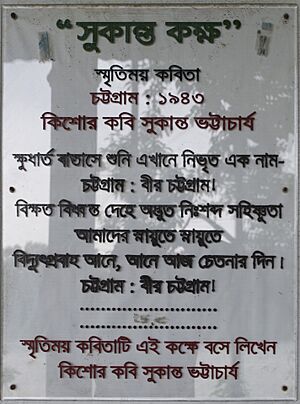Sukanta Bhattacharya facts for kids
Quick facts for kids
Sukanta Bhattacharya
|
|
|---|---|

Bhattacharya in the 1940s
|
|
| Born | 15 August 1926 Calcutta, Bengal Presidency, British India (now West Bengal, India) |
| Died | 13 May 1947 (aged 20) Calcutta, Bengal Presidency, British India (now West Bengal, India) |
| Pen name | Kishore Kabi |
| Occupation | Poet, writer |
| Language | Bengali |
| Nationality | British India |
| Genre | Poet, short-story writer, playwright |
| Subject | Literature |
| Literary movement | Bengali Renaissance |
| Notable works | Chharpatra Purbabhash Ghum Nei Hortal Abhizan |
| Parents | Nibaran Chandra Bhattacharya (father) Suniti Devi (mother) |
| Relatives | Buddhadeb Bhattacharjee (nephew) |
Sukanta Bhattacharya (Bengali: সুকান্ত ভট্টাচার্য) was a talented Bengali poet. He was born on August 15, 1926, and sadly passed away on May 13, 1947.
He was often called 'Young Nazrul' or 'Kishore Bidrohi Kobi'. This means 'Young Rebel Poet'. He got this name because, like the famous poet Kazi Nazrul Islam, Sukanta also wrote poems that spoke out against unfair rules. He challenged the British government and powerful people who treated others badly. Sukanta died very young, just before India became independent.
What Sukanta Wrote About
Sukanta was a poet who believed in communism. He used his writing to speak up against big problems like the Second World War. He also wrote about the terrible famine in 1943, which caused many people to suffer. His poems also spoke out against unfair attacks by fascists and fights between different groups of people.
His poems showed the struggles of everyday people. They talked about how hard it was for them to live. Sukanta dreamed of a world where no one was treated unfairly.
Sukanta's Famous Books
Here are some of his poetry books:
- Chharpatra (ছাড়পত্র) (1948)
- Ghum Nei (ঘুম নেই) (1950)
- Purbabhas (পূর্বাভাস) (1950)
- Abhijan (অভিযান) (1953)
- Mithe-Kadha (মিঠে-কড়া) (1951)
- Hartal (হরতাল) (1962)
- Giti Guccha (গীতিগুচ্ছ) (1965)
His experiences with communist ideas greatly influenced his work.
A Powerful Poem
An excerpt from his poem Durmor (দুর্মর) shows his deep love for his country:
সাবাস বাংলাদেশ!
এ পৃথিবী অবাক তাকিয়ে রয়
জ্বলে পুড়ে মরে ছারখার
তবু মাথা নোয়াবার নয়।
This means: "Bravo Bangladesh! The world is amazed! Fired, burned, died and destroyed, but never gave up!" Here, 'Bangladesh' refers to the whole 'Undivided Bengal' region.
Collections of His Work
After Sukanta passed away, all his writings were collected.
- His complete works were put together in a book called Sukanta Samagra (সুকান্ত সমগ্র) in 1967. This book was published by the Saraswat Library in Kolkata. It included all his printed poems, some lesser-known writings, his plays, and his stories. Some of his stories were Khudha (Hunger) and Daradi Kishorer Svapna (Dream of a Compassionate Adolescent). It also had an article and some of his letters.
- Another collection of his letters is called Patra Guchha (পত্রগুচ্ছ).


